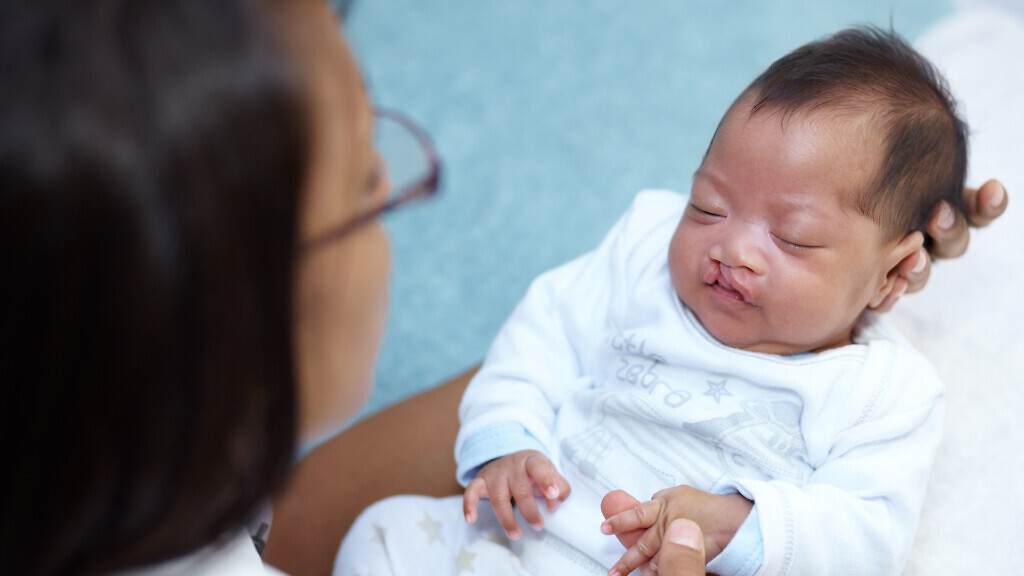The UK’s centralised approach to cleft care has become a beacon of excellence, revolutionising treatment and outcomes for children born with cleft lip and/or palate. Thanks to innovations driven by multidisciplinary teams, more than 4,000 families have experienced world-class care, making the UK a leader in cleft treatment.
A unified approach to exceptional care
Since the late 1990s, cleft care in the UK has been considered world-leading, with the establishment of 11 specialist NHS centres providing integrated, multidisciplinary support.
A combination of research and the centralisation of care means that children born with a cleft lip and/or palate are treated by a huge multi-disciplinary team consisting of surgeons, anaesthetists, nurse specialists, dentists, orthodontists, paediatricians, speech and language therapists, ENT surgeons, audiological physicians, audiologists, psychologists and geneticists.
Data from the Cleft Care UK (CCUK) survey and the Cleft Registry and Audit Network (CRANE) database confirms the system is delivering world-class care, with a staggering 94% of families contacted by a member of their local cleft team within 24 hours of receiving a diagnosis for their baby.
“UK cleft care was falling behind in the 1990s and we needed to fundamentally change how we delivered care to children with cleft lip and/or palate,” says consultant cleft and plastic surgeon David Sainsbury of Newcastle’s Royal Victoria Infirmary.
“We looked at teams across the world, taking the best of each, and, in 1998, the Cleft Clinical Standards Advisory Group initiated a series of improvements that led to the establishment of specialist centres with multidisciplinary teams. By drawing inspiration from global best practices, we developed what is now potentially regarded as the gold standard of cleft care. CRANE, which monitors the care of more than 24,000 children, has enabled us to see real-world results that demonstrate how this approach has transformed the lives of so many children and their parents. Early intervention and robust care are the cornerstones of successful outcomes: our aim is to allow any child born with a cleft to fulfil their potential so that they can achieve whatever they want in life.”

A global vision for cleft care
Sainsbury, who is also a trustee of CLEFT: Bridging the Gap, charity focused on providing permanent, sustainable ways to improve cleft care in both the UK and overseas, highlights the need for international collaboration: “We need to collaborate with cleft teams from low- and middle-income countries to enable high quality, sustainable cleft care to be provided globally. Working alongside talented surgeons and cleft teams in these units we can help each other and mutually learn, whilst respecting the available resources, to provide dramatic physical, psychological and societal changes.
“The aim of the CLEFT charity is for each cleft service in the UK to twin with an overseas cleft team to facilitate this goal. It is very humbling to visit an area of the world where cleft surgery is not routinely performed within that country’s health service and where the impact of a repaired cleft lip or palate can be realised. For example, patients with unrepaired cleft lip or palate will often not go to school, may live in isolation, be kept away from wider society, and never have a job or get married. We are so fortunate in the UK to be able to provide high quality cleft care which dramatically changes facial and dental appearance, helps feeding and general nutrition, improves the clarity of speech, and restores confidence and self-esteem.”

Case study – The human impact: Michael’s journey
For families like Kerry Hedley’s, centralised cleft care has been life-changing. Kerry learned at her 20-week scan that her son Michael had a bilateral cleft lip and possible cleft palate. From diagnosis, Kerry’s family received compassionate, comprehensive care, including feeding support, speech therapy, and tailored surgical plans.
Michael was born at 36 weeks and taken to special care where he was fitted with a feeding tube due to feeding difficulties. A team of cleft nurses worked with Michael during his nine days in special care, teaching him how to feed from a bottle. Michael was put under the care of consultant cleft and plastic surgeon Mr. David Sainsbury who outlined to Kerry and Steven exactly what to expect.
“Michael’s cleft was so symmetrical and perfect in its own way. When I looked at him, I saw a beautiful baby, and I fell in love with every part of him, cleft included,” says Kerry. “There was a part of me that felt sad when I thought about the surgeries that would change his appearance. I remember thinking I could keep him this way forever,”
Michael underwent two operations, the first repaired his lip and the second his palate. Palate repair is significant from a speech and language perspective as it helps babies make sounds that involve using the tongue on the roof of the mouth. Michael quickly demonstrated the success of his operation by saying ‘Dad’ for the first time, a moment that will stay with Kerry and her partner forever.
Kerry met Michael’s multi-disciplinary team when he was three months old, and was impressed by the wide array of support, which even included sleep studies to help Michael with nighttime sleep. Michael’s care will continue until he is 20.
“The support we received from the entire team was astounding,” continues Kerry. “I feel so grateful to each and every person and organisation who have played, and will continue to play, a part in Michael’s life. Thinking about the early days, I realise how crucial it was to have that network around us, and how lucky we are to continue to have them by our side each step of the way.”
Michael will need a further operation between the age of 7 and 11, depending on the progress of his adult teeth, as well as a possible operation on grommets, which are common in children with cleft lip and/or palate. He may also need an alveolar bone graft to strengthen his gum.
“For parents who are just starting this journey with their child, I want to say, everything will be okay. It sounds cliché, but it’s true,” says Kerry. “This journey is tough, but every milestone your child reaches will bring such joy and pride. They are the strongest little fighters, and their smiles after overcoming each challenge are so rewarding. Building a strong support network is vital. Having family, friends, and organisations to lean on makes a world of difference.”



